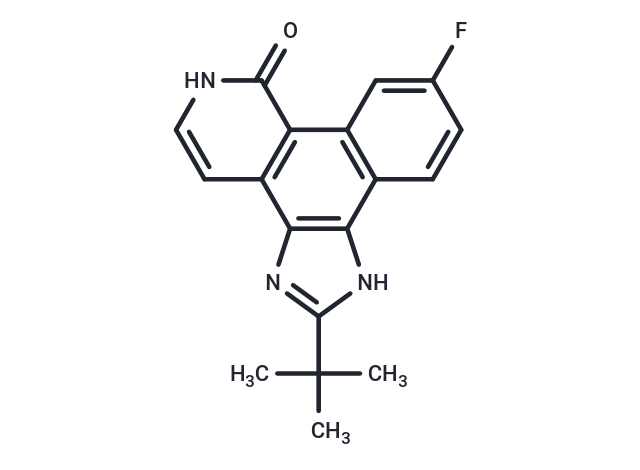Shopping Cart
- Remove All
 Your shopping cart is currently empty
Your shopping cart is currently empty

Pyridone 6 (JAK Inhibitor)(CMP 6) is a potent and selective inhibitor of JAK1 (IC50=15 nM, murine JAK1), JAK2 (IC50=1 nM), JAK3 (Ki=5 nM), and Tyk2 (IC50=1 nM); displaying significantly weaker affinities (130 nM to 10 mM) for other protein tyrosine kinases.

| Pack Size | Price | Availability | Quantity |
|---|---|---|---|
| 1 mg | $75 | In Stock | |
| 2 mg | $108 | In Stock | |
| 5 mg | $165 | In Stock | |
| 10 mg | $233 | In Stock | |
| 25 mg | $473 | In Stock | |
| 50 mg | $693 | In Stock | |
| 100 mg | $988 | In Stock | |
| 500 mg | $1,980 | In Stock | |
| 1 mL x 10 mM (in DMSO) | $186 | In Stock |
| Description | Pyridone 6 (JAK Inhibitor)(CMP 6) is a potent and selective inhibitor of JAK1 (IC50=15 nM, murine JAK1), JAK2 (IC50=1 nM), JAK3 (Ki=5 nM), and Tyk2 (IC50=1 nM); displaying significantly weaker affinities (130 nM to 10 mM) for other protein tyrosine kinases. |
| Targets&IC50 | JAK3:5 nM(Ki), TYK2:1 nM, JAK1:15 nM, JAK2:1 nM |
| In vitro | Pyridone 6 (P6) is shown to inhibit kinase by interacting within the ATP-binding cleft of each JAK. The IC50 of Pyridone 6 is 3 nM for all of these cytokines; this is comparable to the reported IC50s of Pyridone 6 for JAK2, Tyk2, and JAK3. Pyridone 6 strongly inhibits Th2 and modestly inhibits Th1, whereas it enhances Th17 development when present within a certain range of concentrations. Pyridone 6 reduces IFN-γ and IL-13, whereas it enhances IL-17 and IL-22 expression. Pyridone 6 also inhibits both Th1 and Th2 development, whereas it promotes Th17 differentiation from naive T cells when present within a certain range of concentrations[1]. Pyridone 6 inhibits osteoclast differentiation in mouse bone marrow macrophage (BMM) cultures stimulated by the receptor activator of nuclear factor-k B (NF-k B) ligand (RANKL) and co-cultures of bone marrow cells and osteoblasts. Pyridone 6 suppresses the expression of c-Fos and nuclear factor of activated T cells (NFAT) c1 in BMMs. Pyridone 6 also suppresses I-k B degradation and extracellular signal-regulated kinase (ERK) in mature osteoclasts, suggesting that these are the key molecules that pyridone 6 targets in the inhibition of osteoclast function[2]. Pyridone 6 (P6), is found to inhibit the JAKs in the low nanomolar range (IC50, 1-15 nM) and blocks IL-2-dependent proliferation of CTLL cells. Pyridone 6 is a reversible ATP inhibitor, and when tested against many other kinases, IC50s of >130 nM are required[3]. |
| In vivo | Pyridone 6 (P6) postpones the initiation and diminishes the severity of skin conditions in an AD-like model using NC/Nga mice, effectively mitigating atopic dermatitis (AD) symptoms. Its efficacy is on par with betamethasone ointment, a standard treatment, also serving as a positive control. Conversely, empty PLGA nanoparticles (C-nano) appear ineffective[1]. |
| Kinase Assay | Kinase Assays: Baculovirus-expressed glutathione S-transferase-tagged proteins encoding the intracellular domain of IGF-1R (amino acids 957-1367) and IR (amino acids 979-1382) are used for determinations of IC50s by a homogeneous time-resolved fluorescence assay. A filter binding assay is used for appKi determinations using activated IGF-1R and IR kinases. Expanded kinase-selectivity profiling of GSK1838705A is carried out by screening the compound in the KinaseProfiler panel. |
| Cell Research | Pyridone 6 (P6) is prepared in DMSO and stored, and then diluted with appropriate medium before use[1]. Naive CD4+ T cells are treated with various concentrations of Pyridone 6 in RPMI 1640 medium 1 h before the appropriate cytokines are added to create each Th-differentiating condition. Immunoblotting is performed using antiphospho-STAT protein Abs or anti-total STAT protein Abs[1]. |
| Alias | Janus-Associated Kinase Inhibitor I, JAK Inhibitor I, JAK I inhibitor, CMP 6 |
| Molecular Weight | 309.34 |
| Formula | C18H16FN3O |
| Cas No. | 457081-03-7 |
| Smiles | CC(C)(C)c1nc2c([nH]1)c1ccc(F)cc1c1c2cc[nH]c1=O |
| Relative Density. | 1.328 g/cm3 |
| Storage | Powder: -20°C for 3 years | In solvent: -80°C for 1 year | Shipping with blue ice. | |||||||||||||||||||||||||
| Solubility Information | DMSO: 12 mg/mL (38.79 mM), Sonication is recommended. | |||||||||||||||||||||||||
Solution Preparation Table | ||||||||||||||||||||||||||
DMSO
| ||||||||||||||||||||||||||

Copyright © 2015-2025 TargetMol Chemicals Inc. All Rights Reserved.